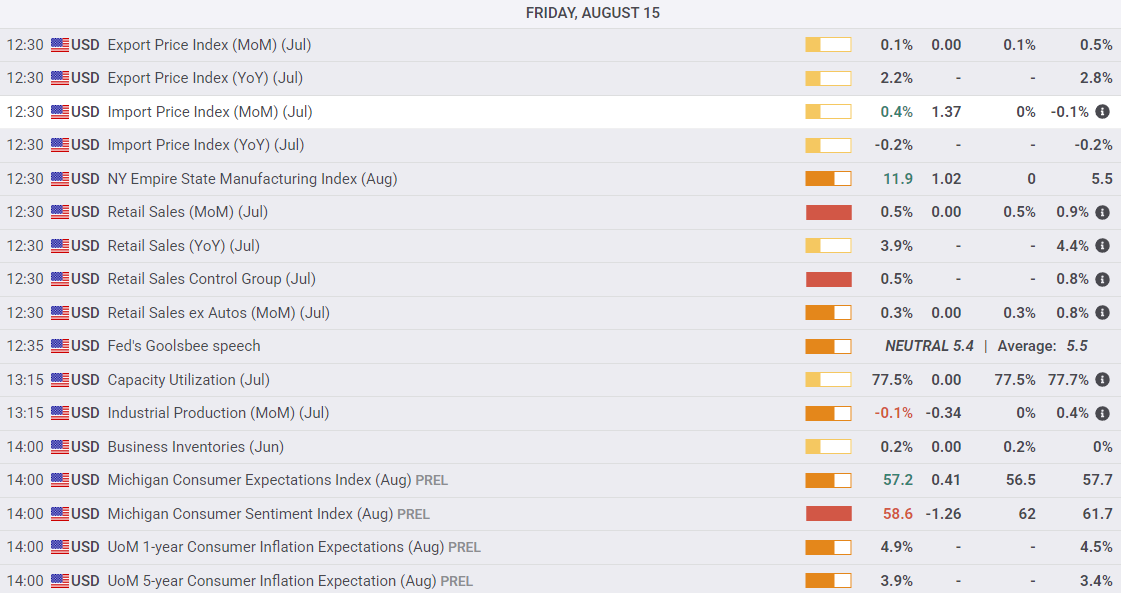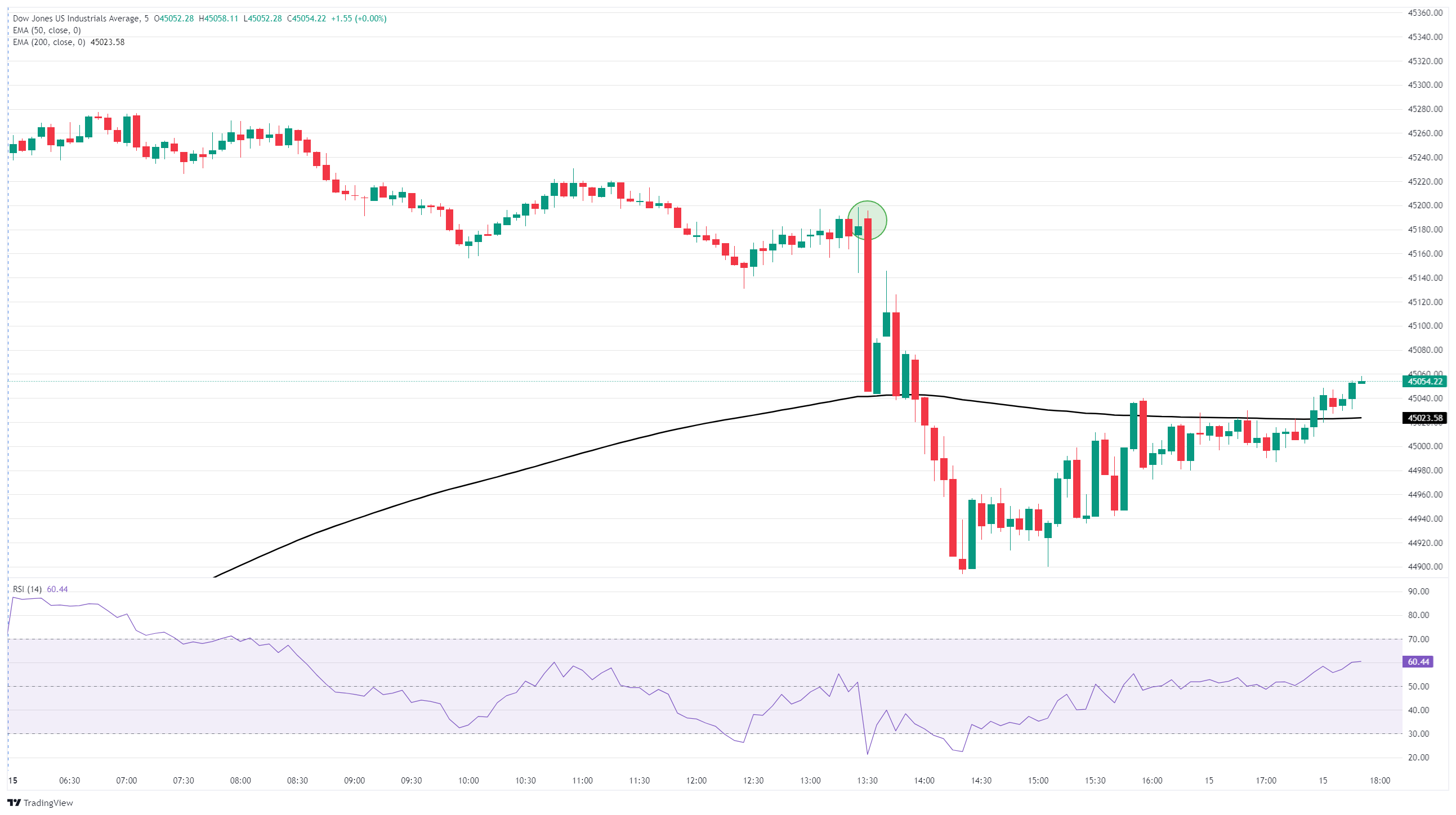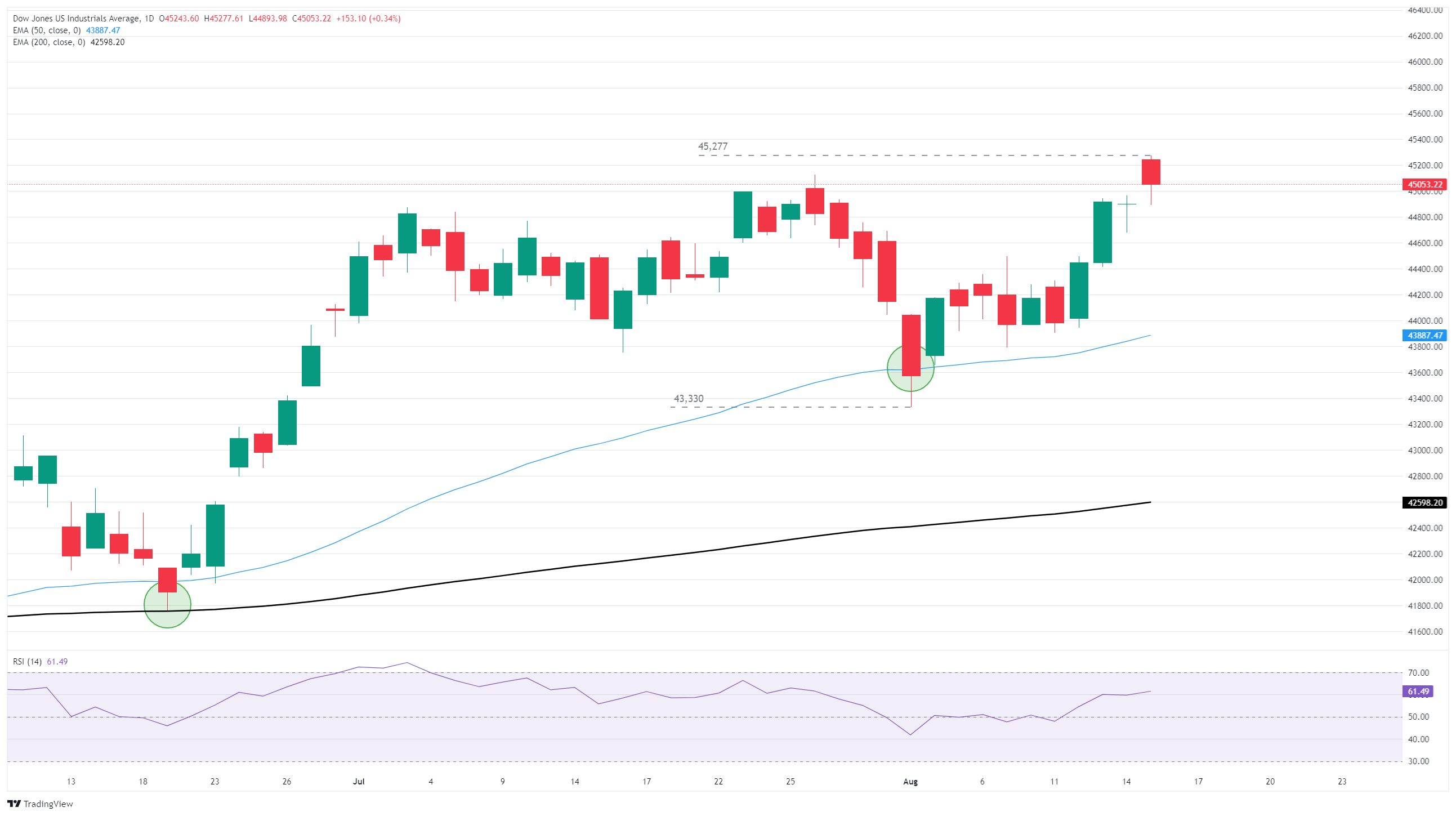Created
: 2025.08.16














![]() 2025.08.16 02:59
2025.08.16 02:59
The Dow Jones Industrial Average (DJIA) surged to record highs early on Friday, touching chart territory north of 45,250 for the first time ever. However, tepid consumer sentiment data and a looming meeting between United States (US) President Donald Trump and Russian President Vladimir Putin are weighing on investor sentiment to wrap up the trading week.
The Dow Jones has tapped in a new all-time high of 45,277 but remains caught in congestion near the 45,000 major handle while rounding the corner into the closing bell. Fundamentals have driven most of the meaningful near-term price action as the Dow continues to drift higher following a technical bounce from the 50-day Exponential Moving Average (EMA) after chalking in the last swing low near 43,330. The 50-day EMA is now providing a technical floor near 43,885, ready to catch any short-term downturns.
US Retail Sales for July came in broadly as expected, rising 0.5% MoM while June's figure saw an upside revision to 0.9% MoM. While up is generally considered good, US Retail Sales data is nominal, meaning the economic indicator does not differentiate whether an extra dollar spent at the checkout is due to increased spending capacity or higher prices resulting from trade taxes.
The US Import Price Index rose 0.4% MoM in July, well above the flat 0.0% forecast and the previous month's -0.1%. A rising Import Price Index implies that US importers are struggling to offset tariff costs with price discounting from exporters, a move that one would expect to occur if the US's economic domination was forcing foreign businesses to absorb tariff costs. For that to hold true, importing costs would not only have to be falling, but they would also have to be falling globally and at a faster rate in the US than anywhere else. This overwhelmingly appears not to be happening.
August's University of Michigan (UoM) Consumer Sentiment Index fell to 58.6. Median market forecasts expected a further improvement to 62.0, but consumer concerns over employment opportunities and future income constraints from rising prices proved calculator-wielding investors wrong. The current economic conditions segment of the UoM's survey deteriorated to 60.8, with future expectations tumbling to 57.2.
12-month consumer inflation expectations also rose to 4.9% compared to 4.5% just a month ago, and the 5-year inflation outlook also accelerated to 4.9% from 4.5%. While consumer forecasts tend to undershoot the bad times and overestimate the good, consumers are feeling the bite from unexpected (for them) increases in the cost of big-ticket durable goods as trade taxes and import tariffs begin to leak through complex supply chains.
Read more stock news: The rumors were right about UnitedHealth Group stock



The Dow Jones Industrial Average, one of the oldest stock market indices in the world, is compiled of the 30 most traded stocks in the US. The index is price-weighted rather than weighted by capitalization. It is calculated by summing the prices of the constituent stocks and dividing them by a factor, currently 0.152. The index was founded by Charles Dow, who also founded the Wall Street Journal. In later years it has been criticized for not being broadly representative enough because it only tracks 30 conglomerates, unlike broader indices such as the S&P 500.
Many different factors drive the Dow Jones Industrial Average (DJIA). The aggregate performance of the component companies revealed in quarterly company earnings reports is the main one. US and global macroeconomic data also contributes as it impacts on investor sentiment. The level of interest rates, set by the Federal Reserve (Fed), also influences the DJIA as it affects the cost of credit, on which many corporations are heavily reliant. Therefore, inflation can be a major driver as well as other metrics which impact the Fed decisions.
Dow Theory is a method for identifying the primary trend of the stock market developed by Charles Dow. A key step is to compare the direction of the Dow Jones Industrial Average (DJIA) and the Dow Jones Transportation Average (DJTA) and only follow trends where both are moving in the same direction. Volume is a confirmatory criteria. The theory uses elements of peak and trough analysis. Dow's theory posits three trend phases: accumulation, when smart money starts buying or selling; public participation, when the wider public joins in; and distribution, when the smart money exits.
There are a number of ways to trade the DJIA. One is to use ETFs which allow investors to trade the DJIA as a single security, rather than having to buy shares in all 30 constituent companies. A leading example is the SPDR Dow Jones Industrial Average ETF (DIA). DJIA futures contracts enable traders to speculate on the future value of the index and Options provide the right, but not the obligation, to buy or sell the index at a predetermined price in the future. Mutual funds enable investors to buy a share of a diversified portfolio of DJIA stocks thus providing exposure to the overall index.
![]()
Created
: 2025.08.16
![]()
Last updated
: 2025.08.16

FXStreet is a forex information website, delivering market analysis and news articles 24/7.
It features a number of articles contributed by well-known analysts, in addition to the ones by its editorial team.
Founded in 2000 by Francesc Riverola, a Spanish economist, it has grown to become a world-renowned information website.
We hope you find this article useful. Any comments or suggestions will be greatly appreciated.
We are also looking for writers with extensive experience in forex and crypto to join us.
please contact us at [email protected].
Disclaimer:
All information and content provided on this website is provided for informational purposes only and is not intended to solicit any investment. Although all efforts are made in order to ensure that the information is correct, no guarantee is provided for the accuracy of any content on this website. Any decision made shall be the responsibility of the investor and Myforex does not take any responsibility whatsoever regarding the use of any information provided herein.
The content provided on this website belongs to Myforex and, where stated, the relevant licensors. All rights are reserved by Myforex and the relevant licensors, and no content of this website, whether in full or in part, shall be copied or displayed elsewhere without the explicit written permission of the relevant copyright holder. If you wish to use any part of the content provided on this website, please ensure that you contact Myforex.
Myforex uses cookies to improve the convenience and functionality of this website. This website may include cookies not only by us but also by third parties (advertisers, log analysts, etc.) for the purpose of tracking the activities of users. Cookie policy